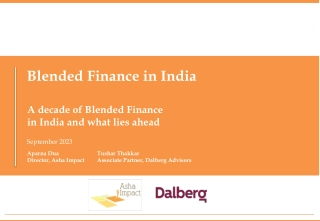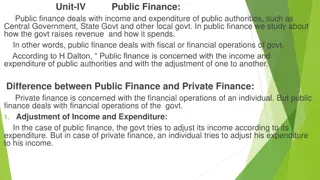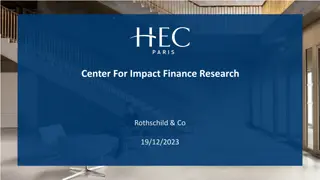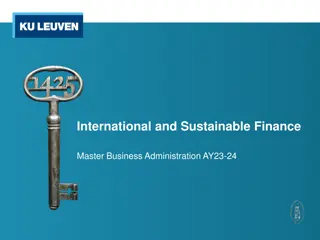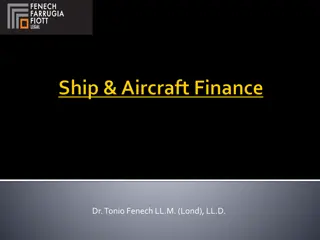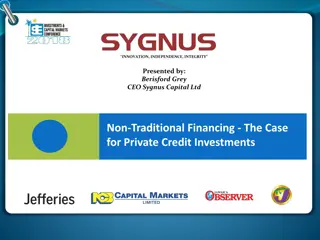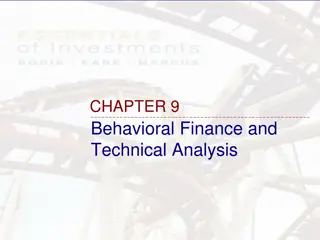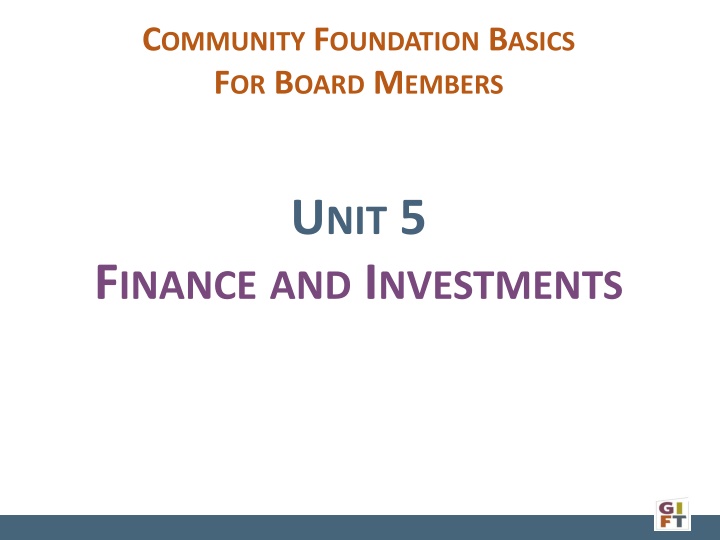
Foundation Board Members: Finance and Investment Essentials
This unit provides comprehensive information for board members of community foundations on finance and investments. It covers topics such as stewardship, fiscal responsibility, investment policies, budgeting, audit procedures, and legal/accounting considerations. The importance of good stewardship, involving fiscal accountability, risk management, operational sustainability, and protecting donors' intentions, is highlighted. Various committees are discussed in relation to investment and financial processes. Key definitions related to investments, asset allocation, investment policies, and spending policies are also explained, along with common investment objectives of community foundations.
Download Presentation

Please find below an Image/Link to download the presentation.
The content on the website is provided AS IS for your information and personal use only. It may not be sold, licensed, or shared on other websites without obtaining consent from the author. If you encounter any issues during the download, it is possible that the publisher has removed the file from their server.
You are allowed to download the files provided on this website for personal or commercial use, subject to the condition that they are used lawfully. All files are the property of their respective owners.
The content on the website is provided AS IS for your information and personal use only. It may not be sold, licensed, or shared on other websites without obtaining consent from the author.
E N D
Presentation Transcript
COMMUNITY FOUNDATION BASICS FOR BOARD MEMBERS UNIT 5 FINANCEAND INVESTMENTS
TOPICS Stewardship and Fiscal Responsibility Investments Budget, Audit and Reporting Legal/Accounting Issues
COMMUNITY FOUNDATION BASICS FOR BOARD MEMBERS UNIT 5 FINANCEAND INVESTMENTS STEWARDSHIPAND FISCAL RESPONSIBILITY
STEWARDSHIPAND FISCAL RESPONSIBILITY GOOD STEWARDSHIP INVOLVES THE FOLLOWING: Fiscal accountability Managing risk Operational sustainability Protecting donors intentions
STEWARDSHIPAND FISCAL RESPONSIBILITY BOARD IS RESPONSIBLE FOR REVIEWING AND APPROVING: 1. Investment and spending policies 2. Annual Budget 3. Approval of Auditor 4. Annual Audit 5. Annual Tax Return (Federal Form 990)
STEWARDSHIPAND FISCAL RESPONSIBILITY Investment Committee Reports and processes dealing with the investment of endowment assets Finance Committee Reports and processes dealing with budgets, interim financial statements, etc. Audit Committee Oversees selection of auditor and annual audit One committee can handle these responsibilities!
COMMUNITY FOUNDATION BASICS FOR BOARD MEMBERS UNIT 5 FINANCEAND INVESTMENTS INVESTMENTS
DEFINITIONS FIRST TOTAL RETURN investment return that includes interest, dividends, realized (occurs when an asset is sold) and unrealized changes in market value ASSET ALLOCATION distribution of investment assets among various asset classes including domestic and foreign stocks, bonds, cash, alternative investments, etc. INVESTMENT POLICY policy that guides all investment activity of the foundation SPENDING POLICY policy that determines the annual spending for grants, scholarships, and administrative fees to cover operating expenses
COMMON INVESTMENT OBJECTIVESOF COMMUNITY FOUNDATIONS Maintain the purchasing power of all endowed assets and future contributions Maximize total return within prudent and reasonable levels of risk Increase the predictability of spending patterns Recognize and fulfill donor wishes
ROLEOF INVESTMENT COMMITTEE Recommend investment and spending policies for approval by the full board Review asset allocation and the performance of individual investment managers on a regular basis Interview and recommend new investment managers to the full board
UMIFA (UPMIFA) The Uniform Management of Institutional Funds Act (UMIFA), adopted in 1972, provided uniform and fundamental rules for the investment of funds held by charitable institutions and the expenditure of funds donated as endowments to those institutions. In 2007, UMIFA was changed to include the word prudent (UPMIFA). The UPMIFA (UMIFA in Indiana) now allowed the boards of institutions with endowment funds to spend principal of endowment funds when considering the following elements: Duration and preservation of the endowment fund Purposes of the foundation and the endowment fund General economic conditions Possible effects of inflation or deflation Expected total return from income and appreciation of investments Other resources of the foundation Investment policy of the foundation UPMIFA UPMIFA
UMIFA (UPMIFA) BUT WHAT ABOUT HISTORIC GIFT VALUE? When a donor makes a gift to an endowment fund he or she expects it to be permanent However, the 2007 change to UPMIFA, now allows the principal portion of an endowment fund to be spent to fulfill grant obligations Historic gift value = is the total of all gifts to an endowment fund The decision to not invade the principal portion of the endowment fund is now the choice of the foundation, based upon its analysis of the economic conditions Historic gift value = principal = permanently restricted Foundations have traditionally not spent the principal portion of an endowment fund
INVESTMENT/SPENDING POLICY The purpose of an investment/spending policy is to provide sufficient return to support the foundation s cash needs, provide for inflation and to protect the historic gift value of the endowment funds. ITEMS TO INCLUDE: 1. Describe duties of the Investment/Finance Committee 2. Clear investment goals and performance objectives 3. Clearly define asset allocation target and ranges 4. Determine investment benchmarks to measure asset performance 5. Monitoring and regular assessment of investment performance against benchmarks 6. Standard evaluation procedure for investment managers 7. Process for changing investment managers
INVESTMENT/SPENDING POLICY The foundation makes payouts for grants and administrative fees from the earnings of the endowment funds each year. In order for the endowed assets to grow, the net total return must be enough for the annual payout needs plus inflation and real growth over time. 4.0% 2.0% 2.0% 0.5% 8.5% the average net expected total return Payout percentage for annual grants Annual administrative fees Estimated inflation factor Investment for real growth
INVESTMENT/SPENDING POLICY Investment Performance 25.00% 21.00% 20.20% 17.60% 16.80% 20.00% 13.50% 12.70% 15.00% 11.10% 9.70%9.00% 6.55% 7.70% 7.00% 6.70% 10.00% 0.77% 5.00% 1.40% 1.60% 4.60% 0.00% -5.00% -4.30% -10.00% -9.30% -15.00% -20.00% Red Line = Desired return of 8.5% (2.0% admin fee + 4.0% target distribution -25.00% -23.70% -30.00% Investment/spending policies use a trailing quarter average Example 12 or 16 quarters Levels out market fluctuations Annual grant distributions are more consistent from year to year
INVESTMENT PROFESSIONALS CUSTODIAN An agent, bank, trust company, or other organization which holds and safeguards the Foundation s assets for them. INVESTMENT ADVISOR A person or organization employed by the Foundation to provide investment advice and evaluate the managers. (Example: FEG, Mason) INVESTMENT OR FUND MANAGER The individual responsible for making decisions related to any portfolio of investments (often a mutual fund, pension fund, or insurance fund), in accordance with the stated goals of the fund.
REQUESTFOR PROPOSAL (RFP) The Foundation should periodically review its relationship with its investment advisors/managers to assure optimal investment performance. PROCESS FOR SELECTING INVESTMENT ADVISORS OR MANAGERS: RFP reviewed by legal counsel prior to distribution Criteria for evaluating RFPs investment goals, fees, philosophy, client satisfaction Communication in a timely manner with firms not chosen Interview process who is involved Conflict of interest disclosed before final decision is made
COMMUNITY FOUNDATION BASICS FOR BOARD MEMBERS UNIT 5 FINANCEAND INVESTMENTS BUDGET, AUDITAND REPORTING
ROLEOF FINANCE COMMITTEE Recommend annual Foundation budget to the full board for approval Monitor Foundation expenditures in accordance with the annualbudget Establish the audit process, select auditor, review annual audit, and present audit results to the full board Auditors work for you-understanding your policies and procedures are important.
BUDGETING Before a budget is completed the annual work plan of the foundation needs to be completed Knowing what activities are planned for the coming year will allow for line items to be adjusted based upon the work plan Reviewing the prior year s budget is helpful to gain an idea of the various line item expenses based upon the past and current year activities
BUDGETING PROCESS What is anticipated date of final approval? Work backwards from this date and develop time-line for budgeting process What is process? Staff prepares draft for Finance Committee review After approval by Finance Committee, presented to Board for final approval o It is important that Treasurer or Chair of Finance Committee presents budget to the Board o More meaningful when peer to peer o Staff can be available for detail questions Important that budget be approved before beginning of new year o This prevents any delay in new year activity waiting for budget approval
BUDGETING REVENUE When it Comes to Sustainability, Not All Revenue Sources are the Same, Some are Much Better than Others Best Administrative Fees on Endowed Funds Payout from Operating Endowment Good Administrative Fees from Pass-through Funds Annual fundraising for Operating Funds Not So Good Grant from Unrestricted Fund Draw on Operating Reserve
BUDGETING EXPENSES EXAMPLES OF OPERATING EXPENSES Personnel Occupancy and Administrative Computer software Staff and volunteer professional development Donor Services Marketing & Communications Grants & Community Leadership Professional Services Audit, etc.
BUDGETING EXPENSES CAPITAL EXPENDITURES Office Furniture * Office Equipment Computers * Buildings How do you budget for these? How do you pay for these? Do you have an operating reserve? Capital expenditures General operating
ANNUAL AUDIT WHY IS THIS IMPORTANT? Required by National Standards Provides external stakeholders with an independent and objective opinion of the organization s financial health Provides Management Letter to the Board of Directors identifying any material weaknesses in internal controls
ANNUAL AUDIT WHO IS RESPONSIBLE FOR THE AUDIT? Audit Committee of the Board of Directors Must be designated by the board Can be same committee as Finance/Investment Committee Should have an initial meeting with the auditor before the audit At completion of the audit, external auditors are required to meet with the Audit Committee to present the audit. Staff should be excused for a portion of this meeting so that auditors can speak freely with Audit Committee about any issues After acceptance by the Audit Committee, the final audited financial statements and management letter are recommended for acceptance by the Board of Directors Acceptance should be documented in the minutes
INTERIM FINANCIAL STATEMENT CLASSIFICATIONS DO NOT EQUAL AUDIT CLASSIFICATIONS Unrestricted Net Assets Operating Funds Temporarily Restricted Assets Pass-Through Funds Permanently Restricted Net Assets Endowment Funds
COMMUNITY FOUNDATION BASICS FOR BOARD MEMBERS UNIT 5 FINANCEAND INVESTMENTS LEGAL/ACCOUNTING ISSUES
AUDITVS. LEGAL LANGUAGE AUDIT = FASB RULES LEGAL = UPMIFA, IRS 900 Financial Accounting Standards Board FASB Audit On the Audit, some of your assets will be reported as liabilities. All of your assets may be reported as unrestricted. This is to comply with FASB standards. FASB standards, known as generally accepted accounting principles (GAAP), govern the preparation of corporate financial reports and are recognized as authoritative by the Securities and Exchange Commission. Federal Form 990 and Internal Reporting All gifts that are made to the community foundation are irrevocable gifts and the community foundation s assets. Each fund has a fund agreement that is the legal document for the community foundation, which describes the donor s intent, as well as how the fund will be administered. On the tax return, all gifts, investment activity, and grants will be included. These numbers will be different from the audit due to the FASB standards.
AUDITVS. LEGAL LANGUAGE (CONFUSED? JOINTHECLUB) 1. FASB 136 Agency Funds Gifts from agencies into an agency endowment are liabilities on the Audit Balance Sheet (donor same as beneficiary) No legal impact on the ownership of these assets; reported as assets on IRS Form 990 and internal statements Materiality can be taken into account 4. FASB 117-1 Reporting Requirements UPMIFA UPMIFA allows for use of permanent portion in certain economic environments Does not remove the fiduciary duty even though it removed the explicit requirement to maintain historic gift value (permanently restricted) Three classifications of asset permanently restricted, temporarily restricted, unrestricted (spendable) 2. FASB 116 Donor Intent Donor intent endowment fund (permanent) 3. FASB 117 Reporting Requirements New reference FASB ASC 958-205 Variance power allows for all assets to be classified as unrestricted
AUDITVS. LEGAL LANGUAGE (CONFUSED? JOINTHECLUB) Board interpret the FASB rules to determine policy Donor intent most important consideration Fund agreements state, principal portion may be committed, granted, or expended pursuant to distribution (or spending) policy Consult attorney Be consistent with interpretation
TAX COMPLIANCE FEDERAL FORM 990 STATE FORM NP-20 Required to be filed 5 months after year end Required to be filed 5 months after year end Information only return No tax due unless Unrelated Business Income Tax (UBIT) Information only return No tax due unless Unrelated Business Income Tax (UBIT) Most important part of Form 990 is Public Support Test Must be at least 33 1/3% or more Form 990 must be reviewed by Board of Directors prior to filing
Sample Investment and Spending Policy Sample RFP for Investment Managers Guidance for Review of 990 Dashboard Samples - 3
Does your board receive a report from the Investment/Finance committee on a regular basis? If so, what information is included? What do you think is important to be included? Does your board understand the total payout that is made each year? For grants? For administrative fees? What has been the investment return history of your foundation? Has it kept up with inflation after payouts are made? When was the last time the investment/spending policy was reviewed by the entire board?

